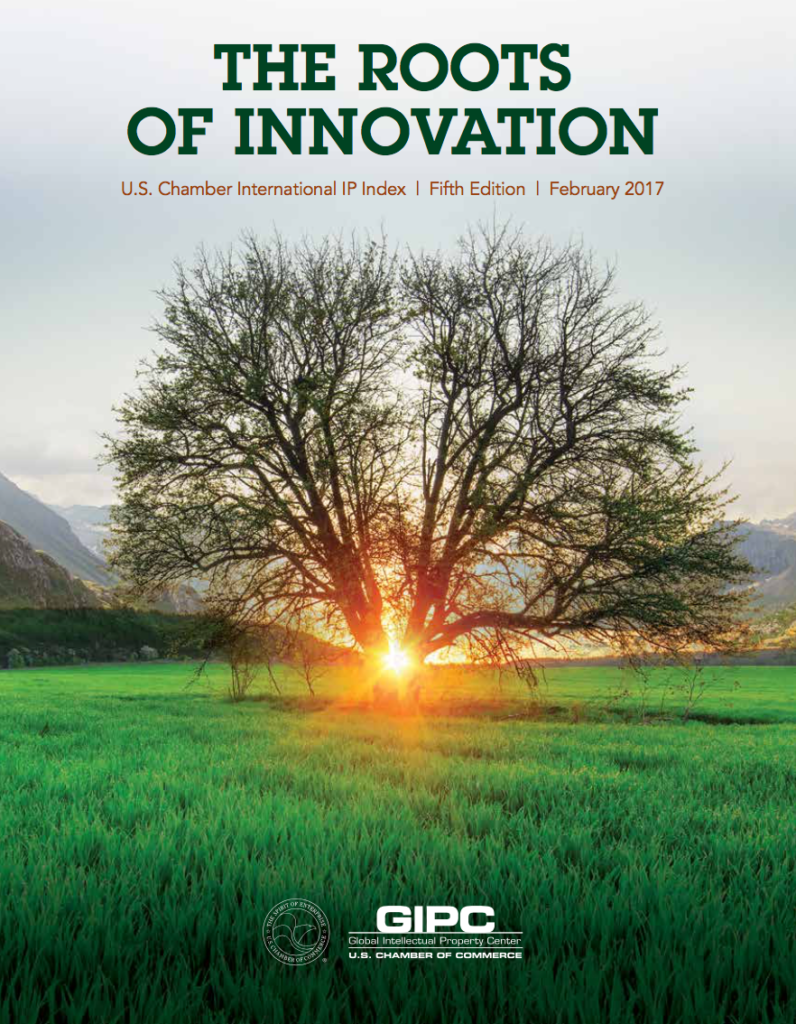U.S. Ranked #1 on Chamber of Commerce 2017 IP Index
Mar 22nd, 2017 by David Puleo | News | Recent News & Articles |
 Last month, The United States Chamber of Commerce (USCC) released the 5th Edition of the International IP Index, entitled “The Roots of Innovation”. The Index, which posts on the USCC’s Global Intellectual Property Center (GIPC) website, was established to highlight the importance of intellectual property (IP) in catalyzing economic growth and development, as well as to cultivate healthy competition between nations. In the current Edition, David Hirschmann, President and CEO of the USCC GIPC, likens IP to a tree. “Just as a tree cannot grow without roots, innovation cannot thrive without intellectual property.” At the most basic level, IP leads to job creation (statistics can be found here on the GIPC website). On a larger scale, IP promotes cross talk and collaboration between multidisciplinary fields, such as medicine, science, and finance.
Last month, The United States Chamber of Commerce (USCC) released the 5th Edition of the International IP Index, entitled “The Roots of Innovation”. The Index, which posts on the USCC’s Global Intellectual Property Center (GIPC) website, was established to highlight the importance of intellectual property (IP) in catalyzing economic growth and development, as well as to cultivate healthy competition between nations. In the current Edition, David Hirschmann, President and CEO of the USCC GIPC, likens IP to a tree. “Just as a tree cannot grow without roots, innovation cannot thrive without intellectual property.” At the most basic level, IP leads to job creation (statistics can be found here on the GIPC website). On a larger scale, IP promotes cross talk and collaboration between multidisciplinary fields, such as medicine, science, and finance.
Initially ranking 11 economies in its First Edition, the current Index now ranks 45 benchmarked economies that comprise 90% of the global gross domestic product based on 35 economic indicators in 6 categories: patents, copyrights, trademarks, trade secrets and market access, enforcement, and ratification of international treaties. The USCC added 5 additional indicators to the current Edition, which highlight the changing digital/software patent landscape. Implementing these indicators is of particular importance, as US Federal Circuit court rulings on “computer-implemented inventions” in cases such as Amdocs1, BASCOM2, Enfish3, and McRO4 have greatly impacted the field.
The United States was ranked #1 in overall score (93%; 32.62/35), which was slightly lower than last year’s score (95%; 28.61/30). It should be noted that the spread between countries in this Edition has been the closest it has ever been previously, likely indicative of the fact that many governments reviewed and updated their IP laws. Not surprisingly, Alice5, Mayo6, and Myriad7 were mentioned as being critical cases that helped shape U.S. patent eligibility requirements and later influenced more recent cases, such as Rapid Litigation8 (another US Federal Ciruit case in the biotech area) and the above-mentioned cases.
The GIPC Executive Summary can be found here. Another succinct synopsis of the Index can be found here on the biotechnology and pharmaceutical patent blog, Patent Docs.
1Amdocs Ltd. v. Openet Telecom, Inc.
2BASCOM Global Internet Services, Inc. v. AT&T MOBILITY LLC
3Enfish, LLC v. Microsoft Corporation
4McRO, Inc. v. Bandai Namco Games America, Inc.
5Alice Corp v. CLS Bank International
6Mayo Collaborative Services v. Prometheus Labs, Inc.
7Association for Molecular Pathology v. Myriad Genetics, Inc.
8Rapid Litigation Management Ltd. v. CellzDirect, Inc.
-David Puleo and Anthony D. Sabatelli, PhD, JD
David Puleo is a Ph.D. Candidate in the Pharmacology Department at Yale University. He is currently involved in two drug discovery projects targeting tyrosine kinases. Prior to attending Yale, David graduated from Boston College with a B.S. in Biochemistry, after which he worked for two years in the Center for Proteomic Chemistry at Novartis Institutes for BioMedical Research in Cambridge, MA.
This article is for informational purposes, is not intended to constitute legal advice, and may be considered advertising under applicable state laws. The opinions expressed in this article are those of the author only and are not necessarily shared by Dilworth IP, its other attorneys, agents, or staff, or its clients.

